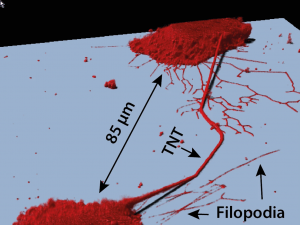Jun 7, 2021
Oh, that huge A&P textbook I teach from! Do I really need to cover all of it? Host Kevin Patton discusses his take on this age-old problem. Does the color of my marking pen send a signal that I don't want to send to my students? A breakthrough in understanding how teeth sense cold. And what in the world is a tunneling nanotube—and can I get one at my local hardware store? Greek names for SARS-CoV-2 variants simplifies conversation and avoids stigma.
00:00 | Introduction
00:43 | How Do Teeth Sense Cold?
07:04 | Sponsored by AAA
08:32 | Red & Green for Student Feedback
18:03 | What's a TNT?
23:52 | Sponsored by HAPI
25:06 | Greek Names for COVID Variants
30:24 | Are A&P Textbooks Too Long? Are Mittens Too Big?
36:41 | Sponsored by HAPS
39:15 | Are A&P Textbooks Too Long? What About Novels?
46:35 | Staying Connected
If you cannot see or activate the audio player, go to: theAPprofessor.org/podcast-episode-94.html
Apply for your credential (badge/certificate) for
listening to this episode: theAPprofessor.org/podcast-episode-94.html/#badge
Please take the anonymous survey: theAPprofessor.org/survey
Questions & Feedback: 1-833-LION-DEN
(1-833-546-6336)
Follow The A&P Professor on Twitter, Facebook,
Blogger,
Revue, Tumblr, or Instagram!
@theAPprofessor
Get the almost-daily TAPP Science & Education
Updates theAPprofessor.org/updates
Do A&P textbooks have too much content? Don't tell me that thought has never occurred to you! (Kevin Patton)
How Do Teeth Sense Cold?
6.5 minutes
We know that teeth damaged by caries (cavities), decay, injury, wear, etc., can be very sensitive to cold—such as ice cream or cold drinks. But we've struggled to come up with a mechanism for that. A new discovery proposes that the ion channel TRCP5 may be the responsible cold sensor. And that may lead to some easy fixes for cold-sensitive teeth.
★ Odontoblast TRPC5 channels signal cold pain in teeth (discovery from Science Advances mentioned in this segment) my-ap.us/3w888Cg
★ Transient receptor potential cation channel, subfamily C, member 5 (TRPC5) is a cold-transducer in the peripheral nervous system (some earlier research on the cold-sensing function of TRPC5) my-ap.us/3pnhdEM
★ Image from PxHere
Sponsored by AAA
1.5 minute
A searchable transcript for this episode, as well as the captioned audiogram of this episode, are sponsored by the American Association for Anatomy (AAA) at anatomy.org.
Don't forget—HAPS members get a deep discount on AAA membership!
Red & Green for For Student Feedback
9.5 minutes
Kevin revisits his recommendation to use a green pen—not a red pen—for marking grades and giving student feedback. That holds over to digital communications, such as course announcements and instructions, too. Listen to the reasons—you may be surprised!
★ No Red Pens! (Kevin’s blog post on this topic; with links to additional information/research) my-ap.us/2SbyDbr
★ Give Your Course a Half Flip With a Full Twist | Episode 6 (Kevin's earlier discussion of green pens for marking)
★ Coblis—Color Blindness Simulator (you can paste in your text with color fonts, or an image, and see what it might look like in major color vision variants) my-ap.us/2T33Xt6
★ Green Pens geni.us/p2BW
★ Photo by animatedheaven from PxHere
What's a TNT?
5.5 minutes
The tunneling nanotube (TNT) is not an organelle we typically discuss in the undergrad A&P course—just like a lot of other recently-discovered organelles. But sometimes it's worth mentioning the ongoing work of discovery in this area—and the excitement of such exploration—as a way to connect students with our course content.
★ Tunneling nanotubes: Reshaping connectivity (review-opinion article mentioned in this segment) my-ap.us/3fUpM6X
★ Wiring through tunneling nanotubes--from electrical signals to organelle transfer (an earlier work from Journal of Cell Science) my-ap.us/3poC5LW
★ Got Proteasomes? (Kevin's brief post about why he teaches proteasomes in A&P) my-ap.us/3pp0NvA
★ Image from Radiation Oncology
Sponsored by HAPI Online Graduate Program
1.5 minute
The Master of Science in Human Anatomy & Physiology Instruction—the MS-HAPI—is a graduate program for A&P teachers, especially for those who already have a graduate/professional degree. A combination of science courses (enough to qualify you to teach at the college level) and courses in contemporary instructional practice, this program helps you be your best in both on-campus and remote teaching. Kevin Patton is a faculty member in this program. Check it out!
Greek Names for COVID Variants
5.5 minutes
Considering the adverse social effects of calling the 1918 influenza "Spanish flu" and the SARS-CoV-2 "the China virus," the World Health Organization has proposed calling variants of SARS-CoV-2 by letters of the Greek alphabet (alpha, beta, gamma, ...) in ordinary conversation. These are to supplement the more technical systems of naming the variants in the scientific literature.
★ Coronavirus variants get Greek names — but will scientists use them? | From Alpha to Omega, the labelling system aims to avoid confusion and stigmatization. (News item in Nature) my-ap.us/3uPC70F
★ Tracking SARS-CoV-2 variants (WHO information that includes a longer list of SARS-CoV-2 variants) my-ap.us/3vZJ0xQ
★ Mid-Winter Winterizing of Our Courses | Bonus Episode 63 (where Spanish flu is discussed)
★ Even More Pandemic Teaching Tips | TAPP 72 (where I apologize for using the term Spanish flu)
★ Image from Wikimedia
Are A&P Textbooks Too Long? Are Mittens Too Big?
6.5 minutes
I first heard complaints about A&P textbooks being too large in the mid-1970s—when they were much smaller on average than today's A&P textbooks. But are they really too large? Let's explore that notion.
★ Your Textbook is a Mitten, Not a Glove (Kevin's brief article
mentioned in this segment) https://my-ap.us/2E0sZP1
READ and RAID your textbook (Kevin's brief article for students on
a useful approach to using their A&P textbook) my-ap.us/2P3KuBZ
★ Selling your textbook? (Kevin's brief article for students on why they need to keep their A&P textbook—to access that "extra content" in their later courses & career) my-ap.us/3g8Q9Fm
★ Plaid Mittens geni.us/yicVmBi
★ Photo from PxHere
Sponsored by HAPS
1 minute
The Human Anatomy & Physiology Society (HAPS) is a sponsor of this podcast. You can help appreciate their support by clicking the link below and checking out the many resources and benefits found there. Watch for virtual town hall meetings and upcoming regional meetings!
Are A&P Textbooks Too Long? What About Novels?
7.5 minutes
Okay, novels can be too long. But only when they're not good. Long, good novels are, um, usually pretty darn good. But we don't dive into every detail of a novel when learning about it in a literature course, do we? What's this got to do with A&P? Listen and find out!
★ The Stranger (novella by Albert Camus) geni.us/Rwbw
★ Photo from PxHere
If the hyperlinks here are not active, go to TAPPradio.org to find the episode page.
★ More details at the episode page: theAPprofessor.org/podcast-episode-94.html
★ Transcript available in the transcript box: theAPprofessor.org/podcast-episode-94.html
★ Need help accessing resources locked behind a
paywall? Check out this advice from Episode 32 to get what
you need! https://youtu.be/JU_l76JGwVw?t=440
Take The A&P Professor experience to the next
level!
★ theAPprofessor.org/community
Earn cash by referring other A&P faculty to
this podcast:
★ theAPprofessor.org/refer
Tools & Resources
★ TAPP Science & Education Updates: theAPprofessor.org/updates
★ Amazon: amzn.to/2r6Qa3J
★ Text Expander: theapprofessor.org/textexpander
★ Rev.com: try.rev.com/Cw2nZ
★ Snagit & Camtasia: techsmith.pxf.io/9MkPW
★ Krisp Free Noise-Cancelling App: theAPprofessor.org/krisp
★ The A&P Professor Logo Items: https://www.teepublic.com/stores/the-a-p-professor
Sponsors
★ Transcript and captions for this episode are supported by the
American Association for
Anatomy | anatomy.org
★ The Human Anatomy & Physiology Society provides marketing support for this podcast | theAPprofessor.org/haps
★ Distribution of this episode is supported by NYCC's online
graduate program in
Human Anatomy & Physiology Instruction
(HAPI) |
nycc.edu/hapi
Clicking on sponsor links helps let them know you
appreciate their support of this podcast!
Follow The A&P Professor on Twitter, Facebook,
Blogger,
Revue, Tumblr, or Instagram
@theAPprofessor
The A&P Professor® and Lion Den® are registered trademarks of
Lion Den Inc. (Kevin Patton)
As an Amazon Associate I earn from qualifying purchases. I
may be compensated for links to sponsors and certain other
links.













